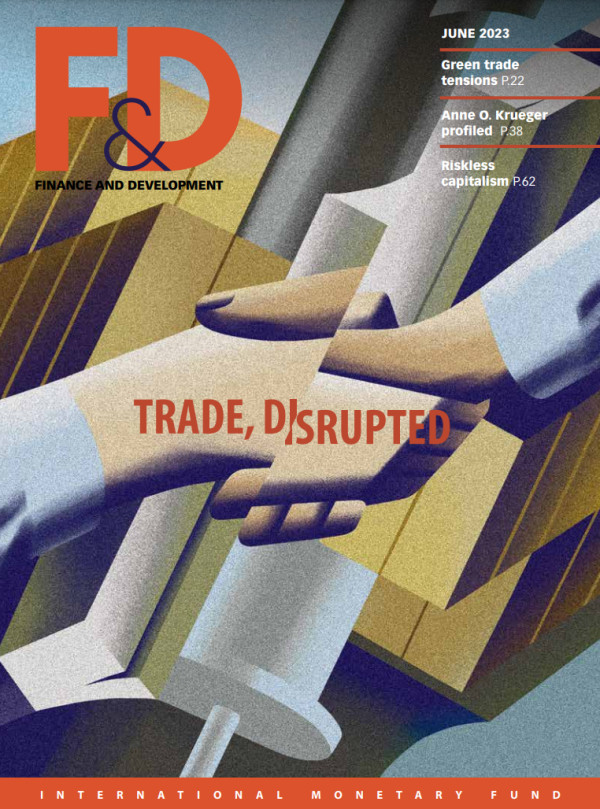The pandemic is accelerating a shift toward more informal and precarious work
With millions of jobs lost, robots on the rise, and white-collar workers toiling largely at home, COVID-19 appears to have ushered in a new normal in the global workplace.
But many of these developments stem from failed policy responses to megatrends already in motion long before the pandemic struck. For at least two decades, shifting demographics and technological upheaval have been upending labor markets, exacerbating inequality, making jobs increasingly precarious, and deepening economic insecurity.
The new normal, in other words, isn’t really new. A deadly virus has simply accelerated the pace of change, with devastating consequences—especially for developing economies, which are expected to lose at least $220 billion in income, according to the United Nations Development Programme.
Now that the crisis is upon us, we should not waste it, as politicians like to say. Policymakers must pursue a more dramatic course correction than previously considered. They must sweep away flawed ideas about jobs and seize this emergency as an opportunity to build resilient, equitable, and sustainable economies.
Changing demographics
This exercise requires more than a return to pre-COVID conditions. It calls for a fundamental reappraisal of our assumptions, beginning with how we view demographics.
Advanced economies—think of Germany, Japan, and the United States—are struggling with aging populations. So are some emerging market economies, including China. But in a majority of developing economies, the youth population is swelling. Some of these countries, such as India, Indonesia, and Nigeria, will approach the peak of their demographic bulge during the next two decades, while smaller countries, such as Angola and Zambia, are in earlier stages of the demographic transition.
Conventional wisdom says that a large and growing population of young adults can provide a demographic dividend by increasing the ratio of workers to dependent children and retirees. But this postulate must be rethought. A youth bulge presents an advantage only if economies can create productive jobs with rising wages. India’s youth population of 362 million, ages 15–29, is higher than the entire population of the United States. At 17.8 percent, the unemployment rate for this cohort was three times that of the overall working population even before the pandemic. Young people in countries that fail the productive job test are likely to end up unemployed or working in poor-quality jobs in the informal economy, which is neither taxed nor monitored by governments (see Back to Basics in this issue of F&D).
Without large-scale job creation, surplus labor in developing economies will exert downward pressure on wages and working conditions. The result will be not only a deteriorating quality of life but also a ceiling on economic growth. We cannot expect the middle class in developing economies to keep expanding if young people cannot find jobs that pay middle-class wages.
As in previous crises, young adults have been among the first affected by the social, educational, and economic disruption. This was borne out by a survey of more than 12,000 young people conducted across 112 countries in April and May, when the pandemic was spawning the worst global recession since World War II (see Picture This in this issue of F&D).
Reporting on the survey, the International Labour Organization (ILO) found that 17 percent of previously employed people between the ages of 18 and 29 stopped working after the pandemic hit, and 42 percent reported a drop in income. In the absence of pathways to productive and high-quality employment, developing economies that pin their economic ambitions on a demographic advantage are setting themselves up for disappointment.
Fast and furious
The pandemic is accelerating the advancement of technology, which was already restructuring labor markets. For many, technology has enhanced efficiency and enabled remote work, but for others, it has disrupted livelihoods. Automation has clearly destroyed some jobs as robots clean hospital floors, tollbooth operators vanish, and chatbots replace customer service agents. Yet digital platforms have also added new and different jobs to the economy—jobs in software programming, health care, and—yes—pizza delivery and taxi services.
The key question is this: Whose jobs will vanish and who can access the new forms of work?
Automation was gaining ground well before COVID-19 hit. This should come as no surprise, especially in places where new technology triggered structural transformation through massive employment shifts in the past—first from farms to factories and then from factories to services.
Where the cost of deploying new technology is low and promises higher output and faster delivery, companies replace workers with machines—as the Luddite handloom weavers learned. Automation is gaining ground faster in developed economies (and in China), where labor costs are relatively high and companies have capital to spare. But developing economies are certainly not immune. They may have a surplus of low-cost labor, but that is only one factor in the overall cost of production.
More companies will automate as the pandemic underscores the vulnerabilities of a human workforce and geographically dispersed global supply chains. Some may also “reshore” production by bringing manufacturing and service jobs back to the United States and Europe—a trend that was emerging before COVID-19. Developing economies must brace for a triple shock: increasing labor substitution as domestic companies automate, at least moderate growth in foreign companies reshoring, and slowing exports as demand remains low.
The pandemic is also fueling the platform economy. From e-commerce to the gig economy, consumers are increasingly tapping the internet to connect with goods and services from the safety of their homes.
The gig economy’s low barriers to entry present new employment opportunities—and new hazards—for developing economies. The danger is that the bulging supply of young and low-skilled workers drawn to platforms is likely to exceed the demand for their services as data processors, customer service representatives, and ride-hailing service drivers.
Not only will these workers frequently find themselves “gigless”—that is, underemployed—but they will likely face downward pressure on working conditions. Evidence from countries where an increasing share of workers compete on gig platforms confirms that wages are getting squeezed. And the assumption that most gig workers were previously in poor-quality informal work doesn’t always hold. A 2015 study by Perkumpulan Prakarsa and the JustJobs Network surveyed 205 on-demand motorbike taxi drivers working through the online taxi-hailing applications Gojek and GrabBike. Of the respondents who were previously employed, 51 percent had been engaged in the formal economy before joining the gig economy.
COVID-19 is also accelerating trends in distance learning and remote work. But these developments widen the gap between the haves and the have-nots—between those who can and cannot afford computers and internet access and between those who do and don’t have the skills to participate in a digitally driven economy.
Growing precarity
As this analysis suggests, the pandemic is driving a shift toward more informal and precarious work among people who are just seeking to make ends meet. Prior to the pandemic, the rise in contractual work notwithstanding, informal employment was stagnant or even declining in some countries. But the pandemic will likely reverse this trend. These informal work arrangements may push down unemployment in developing economies, but the jobs are less secure and tend to be lower-paying and less productive. Policymakers should not be fooled by the numbers. After the pandemic, a decline in the unemployment rate should not be mistaken for economic recovery.
The ILO estimates that workers around the world lost $3.5 trillion in labor income in the first three quarters of 2020 as the pandemic slashed their hours on the job. From simply a health crisis, the pandemic has morphed into both a health and an economic crisis, fostering uncertainty in the business climate and fear among employees.
The risk, for workers, goes well beyond immediate job losses and hiring freezes. The deeper danger is that companies will be less inclined to build permanent workforces, relying instead on cheaper gig, temporary, or contractual workers.
A flexible labor market is valuable when it leads to more efficient allocation of resources. But flexibility that flows from low-productivity work and a decline in working conditions, as is the case in developing economies, does more harm than good—both for workers and society.
People in informal and contractual arrangements and those who are self-employed generally do not receive social security through an employer, leaving them vulnerable to shocks such as from COVID-19. The rise in informal employment also squanders precious productive potential and reduces consumption power, circumscribing broad-based economic development.
Solutions
What must policymakers do to manage these trends and soften their adverse impacts?
First, policymakers must acknowledge that relentless pursuit of economic growth will not automatically create jobs. The priority has to be job-rich growth. This entails advancing sectors that both employ a lot of people and raise growth capacity; for example, infrastructure. It also means investing in increasingly productive labor-intensive sectors and moving up the value chain—for instance, moving from assembly to full package production of apparel or from subsistence farming to food processing. Wage growth should align with increases in productivity.
Second, governments should reject the idea that “any job is better than no job.” That may be true from a destitute worker’s perspective, but it makes little sense economically. Poor-quality jobs exacerbate inequality, waste productive potential, and reduce aggregate demand—all of which are bad for growth. To this end, governments must resist the urge to indiscriminately weaken labor regulations under the pretense that it’s good for business. Appropriately formulated minimum wages, social security, and active labor market policies—including job search assistance and apprenticeship programs—are good for worker productivity and help smooth consumption in times of distress.
Third, governments should recognize that technology, like a genie freed from its bottle, cannot be coaxed away. But they can regulate it. This means putting public interest ahead of commercial interest in mandating data sharing and transparency from tech companies that run digital platforms. Workers who sign on to such labor platforms should have access to public benefits and services. Governments should have access to the data to facilitate evidence-based policymaking. Enforcing competition law more stringently to curb the power of large and growing corporations is essential. Policymakers should revisit corporate taxation, particularly for tech companies that engage in rent seeking and labor arbitrage, to help extend social security coverage to informal and contract workers.
Fourth, the advent of technology and changing demography in developing economies call for investments in reforming and updating human capital to appropriately educate and train young people so that they are more employable. Moreover, as the pandemic alters the economic landscape, creating opportunities for some sectors to thrive while weakening others, policymakers must help workers retool accordingly.
Finally, a myopic focus on boosting efficiency rather than building resilience leaves economies vulnerable. Government investments in health, education, public employment, and social protection systems have all proved their worth. So have fiscal and monetary stimulus. Although these programs can seem inefficient in good times, they provide the necessary space for policymakers to react quickly in uncertain times.
Opinions expressed in articles and other materials are those of the authors; they do not necessarily reflect IMF policy.










